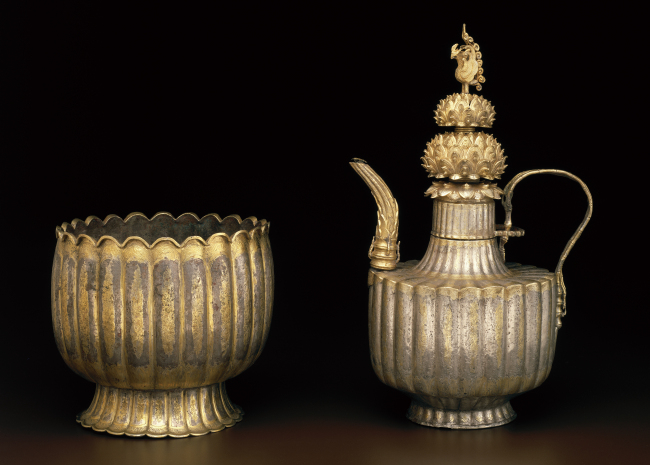Korean crafts have largely been associated with modesty and purity as seen in white porcelain and costumes dating mostly from the Joseon era (1392-1897).
But extravagance and glamour were dominant aesthetics of many crafts made before Confucianism became the ruling ideology. Jewelry boasted delicate and refined designs in gold and silver, and various precious materials such as amber, mother-of-pearl and turquoise were used extensively.
Some of the opulent artifacts of ancient Korea are on display at the Samsung Museum of Art, Leeum. The museum gathered 65 pieces from national museums in Korea and the Museum of Fine Arts, Boston to show the extravagance and opulence that dominated the high society of the Three Kingdoms Period (AD 57-BC 668), Unified Shilla (668-935) and Goryeo (918-1392).
 |
Gilt silver ewer and basin from Goryeo Kingdom, 12th century. (Museum of Fine Arts, Boston/Leeum) |
Among the artifacts on exhibit are nine national treasures and 14 treasures.
The artifacts are not only beautiful treasures, but are also invaluable historical pieces that offer glimpses of ancient Korean society.
Buddhism-related artifacts come in a wide variety of forms. As Buddhism was first introduced to Korea in the Three Kingdoms Period and has remained part of Korean culture ever since, a large number of Buddhist sculptures in diverse designs were produced on the Korean Peninsula.
The highlight of the Buddhist statues is the gold statue from the Unified Silla.
“It’s one of the few surviving Buddhist statues made of pure gold. Most of the Buddha statues are made of silver or bronze and covered with thin layers of gold. But the pure gold of this one makes it stand out among others. Of course, it must have been owned by a high-ranking person,” said Park Min-sun of the museum.
The heavily accessorized, 14th-century gilt-bronze Buddhist statue from the Goryeo era is a reflection of the time when Buddhism reached its peak.
 |
Gold crown from Silla Kingdom, 5th century, Treasure No. 339 (Gyeongju National Museum/Leeum) |
Just as gold has been considered a precious metal, silver has also been a primary material for crafts of the highest quality.
Although silver is more difficult to process than gold, many ornaments have been made in silver ― from crowns, earrings, rings, bracelets and buckles to pendants.
The 12th-century Goryeo gilt silver ewer and basin are rarely seen pieces in Korea that are on loan from the Museum of Fine Arts, Boston for the current exhibition.
The decorative design of the set can still be appreciated though tarnished and discolored.
Accessories decorated with valuable gems such as crystal, amber, coral and pearl make up a significant portion of the exhibition, offering a glimpse into the glamorous lives of ancient royals and aristocrats.
The exhibition “Opulence: Treasures of Korean Traditional Craft” runs through June 2 at Samsung Museum of Art, Leeum in Hannam-dong, Seoul.
For more information, call (02) 2014-6900.
By Lee Woo-young (
wylee@heraldcorp.com)







![[Herald Interview] 'Trump will use tariffs as first line of defense for American manufacturing'](http://res.heraldm.com/phpwas/restmb_idxmake.php?idx=644&simg=/content/image/2024/11/26/20241126050017_0.jpg)

![[Exclusive] Hyundai Mobis eyes closer ties with BYD](http://res.heraldm.com/phpwas/restmb_idxmake.php?idx=644&simg=/content/image/2024/11/25/20241125050044_0.jpg)